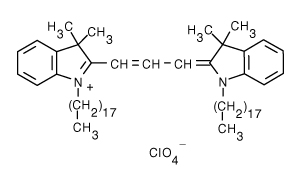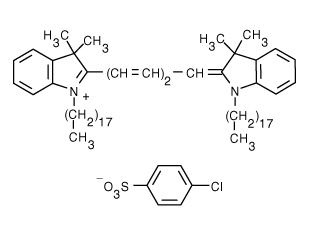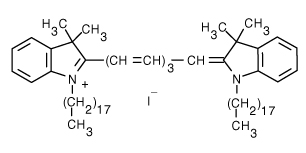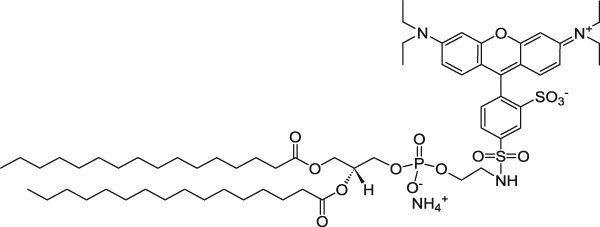PS-based Fluoroliposome®-DBCO for Tracking and Detection
Description
Fluoroliposome® containing a surface reactive lipid can be used in various ways and in different types of experiments.
Phosphatidylserine (PS) based liposomes are negatively charge liposomes.
If you are planning to use a specific fluorophore with a certain property and excitation and emission range, you can simply conjugate the dye (provided that it is already tagged with DBCO or azide) to the surface reactive liposome containing azide or DBCO using click chemistry.
There is a very large catalog of azide reactive dyes that are commercially available by various chemical vendors such as click chemistry tools, Lumiprobe (azide dyes) and many more. In most cases you need to use a reactive liposome formulation that does not contain any fluorophores (e.g. FPG-331) and do the conjugation by following few easy steps.
The surface reactive liposomes are also available with various types of fluorophores such as lipophilic fluorophores incorporated into the lipid membrane of the liposomes with different excitation and emission ranges such as DiA (ex/em: 456/590 nm) , DiD (ex/em: 644/665 nm), DiI (ex/em: 549/565 nm), DiO (ex/em 484/501 nm), DiR (ex/em: 750/780 nm), NBD headgroup tagged lipid (ex/em: 460/535 nm), NBD fatty acid tail tagged lipid (ex/em: 460/534), rhodamine headgroup tagged lipid (ex/em: 560/583 nm) , dansyl headgroup tagged lipid (ex/em: 336/513 nm) and pyrene headgroup tagged lipid (ex/em: 351/379 nm). These liposomes are suitable for conjugation of a non-fluorescent moiety such a peptide or protein provided that the molecule is already tagged with DBCO or azide in order to react with azide or DBCO tagged lipids on the surface of the liposomes. If you are planning to use a reactive fluorophore then you need to make sure that your molecule will not have excitation or emission that can interfere with the excitation or emission of the fluorophore that is already incorporated into the liposomes.
Technical Information
PS-based Fluoroliposome®-DBCO for Tracking and Detection
| Lipid Composition | Concentration (mg/ml) | Concentration (mM) | Molar Ratio Percentage |
|---|---|---|---|
| DOPS | 1.61 | 2.0 | 20 |
| DOPC | 3.80 | 4.9 | 49 |
| Cholesterol | 1.16 | 3.0 | 30 |
| 1,2-dioleoyl-sn-glycero-3-phosphoethanolamine-N-dibenzocyclooctyl | 0.11 | 0.1 | 1 |
| Total | 6.68 mg/ml | 10 mM | 100 |
| Fluorescent Dye | Excitation/Emission (nm) | Molecular Structure |
|---|---|---|
| 1,1'-Dioctadecyl-3,3,3',3'-tetramethylindocarbocyanine perchlorate (DiI) | 549/565 |  |
| 3,3'-Dilinoleyloxacarbocyanine perchlorate (DiO) | 484/501 |  |
| 1,1'-Dioctadecyl-3,3,3',3'-tetramethylindodicarbocyanine, 4-chlorobenzenesulfonate salt (DiD) | 644/665 |  |
| 1,1'-Dioctadecyl-3,3,3',3'-tetramethylindotricarbocyanine iodide (DiR) | 750/780 |  |
| 4-(4-(Dihexadecylamino)styryl)-N-methylpyridinium iodide (DiA) | 456/590 |  |
| 1,2-Distearoyl-sn-glycero-3-phosphoethanolamine-N-(7-nitro-2-1,3-benzoxadiazol-4-yl) (ammonium salt) (NBD on head group) | 460/535 |  |
| 1-Palmitoyl-2-{12-[(7-nitro-2-1,3-benzoxadiazol-4-yl)amino]dodecanoyl}-sn-glycero-3-phosphocholine (NBD on fatty acid tail) | 460/534 |  |
| 1,2-Dipalmitoyl-sn-glycero-3-phosphoethanolamine-N-(lissamine rhodamine B sulfonyl) (ammonium salt) (Rhodamine lipid) | 560/583 |  |
| 1,2-Dioleoyl-sn-glycero-3-phosphoethanolamine-N-(5-dimethylamino-1-naphthalenesulfonyl) (ammonium salt) (Dansyl lipid) | 336/513 |  |
| 1,2-Dipalmitoyl-sn-glycero-3-phosphoethanolamine-N-(1-pyrenesulfonyl) (ammonium salt) (Pyrene lipid) | 351/379 |  |
| 1,2-dioleoyl-sn-glycero-3-phosphoethanolamine-N-(Cyanine 5) (Cyanine 5 lipid) | 639/663 |  |
| 1,2-dioleoyl-sn-glycero-3-phosphoethanolamine-N-(Cyanine 5.5) (Cyanine 5.5 lipid) | 677/707 |  |
| 1,2-dioleoyl-sn-glycero-3-phosphoethanolamine-N-(Cyanine 7) (Cyanine 7 lipid) | 750/773 |  |
| Buffer and Liposome Size | Specification |
|---|---|
| Buffer | PBS |
| pH | 7.4 |
| Liposome Size | 100 nm |
| * If you prefer different buffers, please specify in your order. | |
Technical Notes
- Liposomes are unilamellar and sized to 100 nm. If you need them to be made in another size, then you should mention that at the time of ordering. Unilamellar liposomes can be made in 50 nm and 200 nm sizes. Liposomes that are larger than 200 nm are multilamellar structure.
- Liposomes are made in PBS buffer at pH 7.4 but it can be made in any other buffer of your choice. You can specify your buffer at the time of ordering.
- Liposomes are made in degassed buffer that is purged with argon to avoid oxidation of the unsaturated phospholipids.
- Liposomes are made under sterile condition.
- Liposomes are unilamellar and therefore due to their small size they will not settle in the bottom of the vial.
- If you need to take multiple aliquots out of the vial, for use over a period of time, then it is advised to take extreme care in not contaminating the vial. It is recommended to handle the vial under a sterile hood to maintain the sterility of the product.
- Liposomes should never be frozen. Ice crystals that form during freezing will rupture the lipid membrane of the liposomes and change the size the liposomes particles.
- Liposomes should be kept in refrigerator at 4°C in order to avoid the hydrolysis of the liposomes.
- If you are planning to conjugate a molecule to the surface of the liposomes, then keep in mind that PS-based liposomes are highly negative in charge. It is better to use a reactive dye or molecule that is more neutral in charge rather than a dye or molecule that has a strong positive charge which can cause aggregation.
- Liposomes should be kept at 4°C and NEVER be frozen.
Appearance
PS-based Fluoroliposome®-DBCO formulation is a colored translucent liquid, and the color depends on the type of the fluorescent dye that is used (see SDS for apearance). Usually due to the small size of liposomes no settling will occur in the bottom of the vial. The liposomes are packaged in an amber vial.
Ordering/Shipping Information
- All liposome based formulations are shipped on blue ice at 4°C in insulated packages using overnight shipping or international express shipping.
- Liposomes should NEVER be frozen. Ice crystals that form in the lipid membrane can rupture the membrane, change the size of the liposomes and cause the encapsulated drug to leak out. Liposomes in liquid form should always be kept in the refrigerator.
- Clients who order from outside of the United States of America are responsible for their government import taxes and customs paperwork. Encapsula NanoSciences is NOT responsible for importation fees to countries outside of the United States of America.
- We strongly encourage the clients in Japan, Korea, Taiwan and China to order via a distributor. Tough customs clearance regulations in these countries will cause delay in custom clearance of these perishable formulations if ordered directly through us. Distributors can easily clear the packages from customs. To see the list of the distributors click here.
- Clients ordering from universities and research institutes in Australia should keep in mind that the liposome formulations are made from synthetic material and the formulations do not require a “permit to import quarantine material”. Liposomes are NOT biological products.
- If you would like your institute’s FedEx or DHL account to be charged for shipping, then please provide the account number at the time of ordering.
- Encapsula NanoSciences has no control over delays due to inclement weather or customs clearance delays. You will receive a FedEx or DHL tracking number once your order is confirmed. Contact FedEx or DHL in advance and make sure that the paperwork for customs is done on time. All subsequent shipping inquiries should be directed to Federal Express or DHL.
Storage and Shelf Life
Storage
PS-based Fluoroliposome®-DBCO should always be stored at in the dark at 4°C, except when brought to room temperature for brief periods prior to animal dosing. DO NOT FREEZE. ENS is not responsible for results generated by frozen product.
Shelf Life
Fluoroliposome® products are made on daily basis. The batch that is shipped is manufactured on the same day. It is advised to use the products within 60 days of the manufacturing date.











